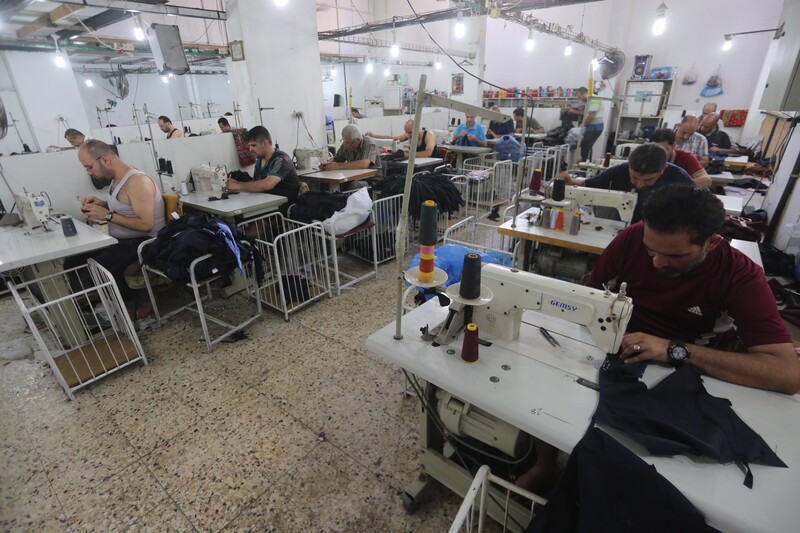The Electronic Intifada 11 September 2017

Israel’s siege has all but killed Gaza’s once vibrant textile industry.
Khalil is being paid less now than he was 30 years ago.
During the 1980s, he used to travel from Gaza to work in the textile factories of Tel Aviv and Bir al-Saba, cities inside Israel. By sewing garments, he could earn 250 to 300 shekels per day.
Today, Khalil – not his real name – receives 50 shekels ($15) per day, an income shrunk considerably compared to three decades ago. Israeli restrictions mean that he is no longer able to travel outside Gaza for employment. Khalil is acutely aware that his wages are about one-tenth of what workers inside Israel receive for doing the same or broadly similar jobs.
“It’s really unfair,” the 48-year-old said. “I know that workers in Israel with half of my experience receive 400 to 500 shekels a day. This is discrimination and exploitation.”
Khalil added that he had “no choice” but to accept lower pay in Gaza than he had received in Israel.
“I have seven children, two of them are university students,” he said. “My wage isn’t enough but it’s better than nothing.”
Revival
Gaza’s textile industry is being revived after years of decline.
The siege, which Israel imposed on Gaza a decade ago, has been so severe that even cloth and thread were banned from being imported to the territory and sending clothes abroad was often impossible.
Recently, Israel has made an exception for textiles, while it still enforces restrictions on the flow of other goods into and out of Gaza.
Following a deal reached with local factory owners, Israel has allowed exports of clothing from Gaza to resume.
Economic factors may explain why textiles have been singled out for preferential treatment.
Negotiations leading to the deal “were not easy,” said Nihad Hamada, an accountant for garment traders in Gaza. “The Israeli side accepted our demands, simply because they will benefit from our products.”
Low wages are a major reason why clothes processed in Gaza have proven attractive to Israel, according to Hamada.
Proximity is another factor. Israeli businesses have lately outsourced some work to Gaza’s factories, rather than to distant China, a dominant player in the global textiles trade.
“Goods need 40 days to arrive from China but four days are enough for items to be processed in Gaza and sent to the Israeli side,” said Hamada.
“Israeli traders don’t have to pay in cash, they can pay by post-dated checks. And traders are forced to buy in big quantities from China but they can buy in very limited quantities from Gaza, which suits their needs more.”
“Unfair”
With Gaza recently suffering from the highest level of unemployment in the world, jobs of any type are welcome.
Yet textile workers – particularly those old enough to remember better times – remain aggrieved that their wage levels have fallen.
As well as providing workers for Israel, Gaza used to have a vibrant textile industry of its own.
Before the second intifada broke out in 2000, Gaza played host to more than 900 garment factories. In total, they employed some 35,000 people. Most of their products were sold in Israel and the occupied West Bank.
The siege reduced the number of workers employed in Gaza’s garment trade to approximately 4,000. The number of garment factories fell to 150.
Mazen – not his real name – has been sewing clothes since 1998. While his father and uncles previously worked in Israel’s garment factories, he has only found employment within Gaza.
During his first two years in the trade, he was paid 100 shekels a day, roughly $25. Following the second intifada his wages have fallen significantly.
“I learned the craft from my father,” he said. “It’s our family’s work. A few kilometers away from Gaza, there are people [inside Israel] who aren’t as skillful as us and they don’t work as much as we do. But they receive wages 10 times more than ours. It’s unfair.”
Israel’s siege has forced factory owners to cut costs, including wages. “The worker is the weakest link,” said Sami al-Amassi, who heads the General Federation of Trade Unions in Gaza.
“With more than 220,000 unemployed workers, the situation is very difficult,” he added. “When a worker finds a job, even with a low salary, they won’t complain because they know that tens of thousands are waiting for such an opportunity.”
The precise nature of the trade between Gaza and Israel is kept secret. Gaza factory owners contacted for this article refused to name any of their Israeli clients.
Tayseer al-Austath, a factory owner who heads the Palestinian Federation of Garment, Textile and Leather Industries, said the value of garment exports from Gaza to Israel and the West Bank rose from $1.5 million in 2015 to more than $3 million last year. For the first six months of this year, such exports have been worth $2 million.
“They hate us”
Despite that increase, Gaza’s traders still have to overcome many hurdles.
“All over the world, businessmen move freely,” al-Austath said. “I think that 60 percent of our job is about being in direct contact with our clients. We face a lot of problems in collecting money from clients.”
The current power crisis in Gaza has also badly affected the textile sector – by pushing up its costs. When Gaza has an uninterrupted supply of power, al-Austath pays an electricity bill for his plant in Gaza City of $850 per month. Now that Gaza has been forced to get by on less than three hours of electricity a day, he has to spend an extra $1,400 per month on fuel for a generator.
Al-Austath argues that Israel has a deliberate policy of preventing Gaza from nurturing its own industries. “They hate us because we work hard and build our country,” he said.
Scholar Toufic Haddad noted that the Israeli economy has generally become less reliant on cheap Palestinian labor. Palestinians in the West Bank and Gaza have been frequently blocked from working inside Israel since the 1990s.
Haddad, author of the book Palestine Ltd: Neoliberalism and Nationalism in the Occupied Territory, said that the 1993 Oslo accords theoretically allow Israel to avail itself of Palestinian labor in a profitable way. Only limited use has been made of such labor, however, because of the “overriding political instability,” he said.
If Israel really wishes to develop a new economic model based on exploiting Palestinians, Haddad added, “there is nothing stopping it making much more serious maneuvers to promote this strategy, starting with permitting free movement and access” for Palestinian workers.
Mousa Tawfiq is a journalist from Gaza.





